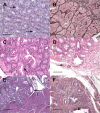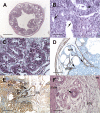Fulminant cryptosporidiosis after near-drowning: a human Cryptosporidium parvum strain implicated in invasive gastrointestinal adenocarcinoma and cholangiocarcinoma in an experimental model
- PMID: 22247151
- PMCID: PMC3298136
- DOI: 10.1128/AEM.06457-11
Fulminant cryptosporidiosis after near-drowning: a human Cryptosporidium parvum strain implicated in invasive gastrointestinal adenocarcinoma and cholangiocarcinoma in an experimental model
Abstract
In the present work, we report the characterization of a Cryptosporidium parvum strain isolated from a patient who nearly drowned in the Deule River (Lille, France) after being discharged from the hospital where he had undergone allogeneic stem cell transplantation. After being rescued and readmitted to the hospital, he developed fulminant cryptosporidiosis. The strain isolated from the patient's stools was identified as C. parvum II2A15G2R1 (subtype linked to zoonotic exposure) and inoculated into SCID mice. In this host, this virulent C. parvum isolate induced not only severe infection but also invasive gastrointestinal and biliary adenocarcinoma. The observation of adenocarcinomas that progressed through all layers of the digestive tract to the subserosa and spread via blood vessels confirmed the invasive nature of the neoplastic process. These results indicate for the first time that a human-derived C. parvum isolate is able to induce digestive cancer. This study is of special interest considering the exposure of a large number of humans and animals to this waterborne protozoan, which is highly tumorigenic when inoculated in a rodent model.
Figures


Similar articles
-
Fulminant cryptosporidiosis associated with digestive adenocarcinoma in SCID mice infected with Cryptosporidium parvum TUM1 strain.Int J Parasitol. 2010 Nov;40(13):1469-75. doi: 10.1016/j.ijpara.2010.07.007. Epub 2010 Aug 12. Int J Parasitol. 2010. PMID: 20708621
-
Cryptosporidium parvum-induced ileo-caecal adenocarcinoma and Wnt signaling in a mouse model.Dis Model Mech. 2014 Jun;7(6):693-700. doi: 10.1242/dmm.013292. Epub 2014 Mar 20. Dis Model Mech. 2014. PMID: 24652769 Free PMC article.
-
Cryptosporidium parvum infection in SCID mice infected with only one oocyst: qPCR assessment of parasite replication in tissues and development of digestive cancer.PLoS One. 2012;7(12):e51232. doi: 10.1371/journal.pone.0051232. Epub 2012 Dec 13. PLoS One. 2012. PMID: 23272093 Free PMC article.
-
Zoonotic cryptosporidiosis.FEMS Immunol Med Microbiol. 2008 Apr;52(3):309-23. doi: 10.1111/j.1574-695X.2008.00377.x. Epub 2008 Jan 18. FEMS Immunol Med Microbiol. 2008. PMID: 18205803 Review.
-
Molecular targets for detection and immunotherapy in Cryptosporidium parvum.Biotechnol Adv. 2007 Jan-Feb;25(1):13-44. doi: 10.1016/j.biotechadv.2006.08.003. Epub 2006 Aug 30. Biotechnol Adv. 2007. PMID: 17055210 Review.
Cited by
-
Colorectal cancer and Cryptosporidium spp. infection.PLoS One. 2018 Apr 19;13(4):e0195834. doi: 10.1371/journal.pone.0195834. eCollection 2018. PLoS One. 2018. PMID: 29672572 Free PMC article.
-
Cryptosporidium and Colon Cancer: Cause or Consequence?Microorganisms. 2020 Oct 27;8(11):1665. doi: 10.3390/microorganisms8111665. Microorganisms. 2020. PMID: 33121099 Free PMC article. Review.
-
Deciphering Host-Pathogen Interactions: Role of Cryptosporidium in Tumorigenesis.Pathogens. 2025 Feb 20;14(3):208. doi: 10.3390/pathogens14030208. Pathogens. 2025. PMID: 40137692 Free PMC article. Review.
-
Therapeutic Potency of Ginger, Garlic, and Pomegranate Extracts Against Cryptosporidium parvum-Mediated Gastro-Splenic Damage in Mice.Acta Parasitol. 2023 Mar;68(1):32-41. doi: 10.1007/s11686-022-00635-0. Epub 2022 Nov 8. Acta Parasitol. 2023. PMID: 36348178 Free PMC article.
-
Parasite-microbe-host interactions and cancer risk.PLoS Pathog. 2019 Aug 15;15(8):e1007912. doi: 10.1371/journal.ppat.1007912. eCollection 2019 Aug. PLoS Pathog. 2019. PMID: 31415672 Free PMC article. No abstract available.
References
-
- Blanshard C, Jackson AM, Shanson DC, Francis N, Gazzard BG. 1992. Cryptosporidiosis in HIV-seropositive patients. Q. J. Med. 85:813–823 - PubMed
-
- Bulckaen H, et al. 2008. Low-dose aspirine prevents age-related endothelial dysfunction in a mouse model of physiological aging. Am. J. Physiol. Heart Circ. Physiol. 294:H1562–H1570 - PubMed
-
- Certad G, et al. 2010. Fulminant cryptosporidiosis associated with digestive adenocarcinoma in SCID mice infected with Cryptosporidium parvum TUM1 strain. Int. J. Parasitol. 40:1469–1475 - PubMed
Publication types
MeSH terms
LinkOut - more resources
Full Text Sources
Medical

